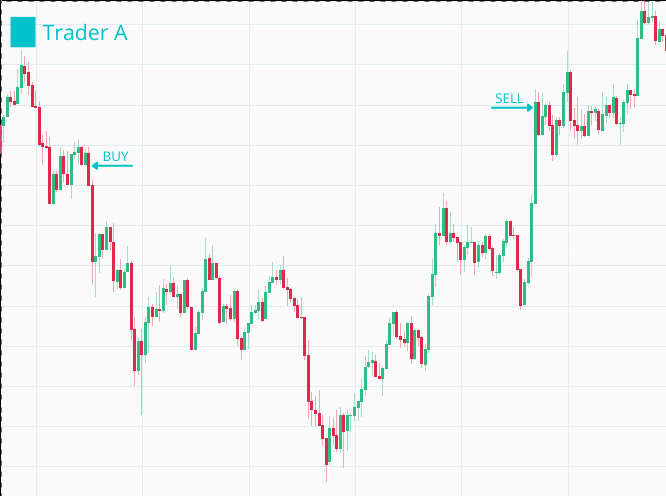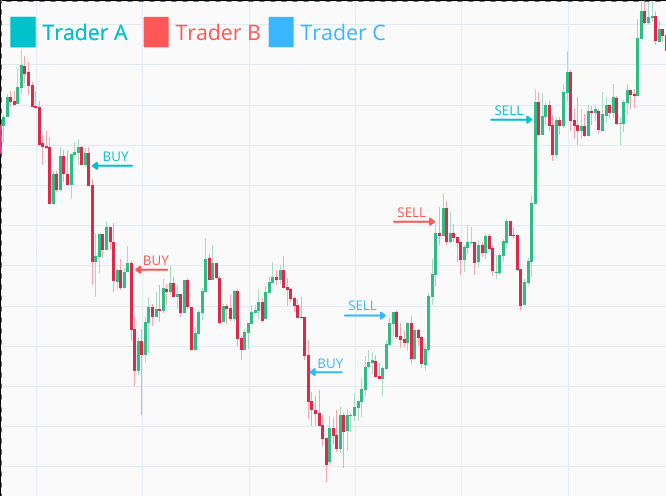Chapter 9 Run multiple traders in parallel
9.1 Objectives
- describe and design the required functionality
- implement rebuy in the
Naive.Trader - implement rebuy in the
Naive.Leader - improve logs by assigning ids to traders
9.2 Describe and design the required functionality
At this moment, inside the Naive.Leader we have a silly code that starts all of the traders at the same moment:
# /apps/naive/lib/naive/leader.ex
...
traders =
for _i <- 1..settings.chunks,
do: start_new_trader(trader_state)
...All the changes we made in this episode will enable us to fix this.
Let’s say that we placed a buy order that got filled and the price has fallen before reaching the sell level. We can see here that we missed a nice opportunity to buy more as price drops and make money as it climbs back:

We will implement an additional trade event callback inside the Naive.Trader that will keep checking the price after the buy order has been filled. Whenever a price drops below the buy_order’s price by rebuy_interval we will notify the Naive.Leader to start the new Naive.Trader process:

The Naive.Leader keeps track of how many Naive.Traders are running and needs to honor the number of chunks set up in the settings (one chunk == one trader).
To stop the Naive.Traders from continuously notifying about a drop in the price we will also introduce a boolean flag that will track has the Naive.Leader been already notified.
9.3 Implement rebuy inside Naive.Trader
We will start by adding the rebuy_interval and the rebuy_notified to the trader’s state:
# /apps/naive/lib/naive/trader.ex
...
defmodule State do
@enforce_keys [
:symbol,
:budget,
:buy_down_interval,
:profit_interval,
:rebuy_interval, # <= add this field
:rebuy_notified, # <= add this field
:tick_size,
:step_size
]
defstruct [
:symbol,
:budget,
:buy_order,
:sell_order,
:buy_down_interval,
:profit_interval,
:rebuy_interval, # <= add this field
:rebuy_notified, # <= add this field
:tick_size,
:step_size
]
endRebuy logic should be placed almost as the last callback just before the one that ignores all events. We will need to retrieve the current price and buy_price and confirm that we didn’t notify the leader yet(rebuy_notified flag):
# /apps/naive/lib/naive/trader.ex
...
# sell filled callback here
...
def handle_info(
%TradeEvent{
price: current_price
},
%State{
symbol: symbol,
buy_order: %Binance.OrderResponse{
price: buy_price
},
rebuy_interval: rebuy_interval,
rebuy_notified: false
} = state
) do
end
# catch all callback hereWe need to calculate is the current price below the rebuy interval. If yes we will notify the leader and update the boolean flag. We will abstract calculation to separate function(for readability) that we will write below:
# /apps/naive/lib/naive/trader.ex
# body of the above callback
if trigger_rebuy?(buy_price, current_price, rebuy_interval) do
Logger.info("Rebuy triggered for #{symbol} trader")
new_state = %{state | rebuy_notified: true}
Naive.Leader.notify(:rebuy_triggered, new_state)
{:noreply, new_state}
else
{:noreply, state}
endAs mentioned before, we will set the rebuy_notified boolean flag to true and notify the leader using the notify function with the dedicated atom.
At the bottom of the module we need to add the trigger_rebuy? helper function:
9.4 Implement rebuy in the Naive.Leader
Moving on to the Naive.Leader module, we can get update starting of the traders automatically by the leader to starting just one inside handle_continue:
# /apps/naive/lib/naive/leader.ex
def handle_continue(:start_traders, %{symbol: symbol} = state) do
...
traders = [start_new_trader(trader_state)] # <= updated part
...
endWe will need to add a new clause of the notify function that will handle the rebuy scenario:
# /apps/naive/lib/naive/leader.ex
# add below current `notify` function
def notify(:rebuy_triggered, trader_state) do
GenServer.call(
:"#{__MODULE__}-#{trader_state.symbol}",
{:rebuy_triggered, trader_state}
)
endWe need to add a new handle_call function that will start new traders only when there are still chunks available(enforce the maximum number of parallel traders) - let’s start with a header:
# /apps/naive/lib/naive/leader.ex
# place this one after :update_trader_state handle_call
def handle_call(
{:rebuy_triggered, new_trader_state},
{trader_pid, _},
%{traders: traders, symbol: symbol, settings: settings} = state
) do
endThere are few important details to make note of:
- we need the trader’s PID to be able to find it details inside the list of traders
- we need settings to confirm the number of chunks to be able to limit the maximum number of parallel traders
Moving on to the body of our callback. As with other ones, we will check can we find a trader inside the list of traders, and based on that we will either start another one(if we didn’t reach the limit of chunks) or ignore it:
# /apps/naive/lib/naive/leader.ex
# body of our callback
case Enum.find_index(traders, &(&1.pid == trader_pid)) do
nil ->
Logger.warning("Rebuy triggered by trader that leader is not aware of")
{:reply, :ok, state}
index ->
old_trader_data = Enum.at(traders, index)
new_trader_data = %{old_trader_data | :state => new_trader_state}
updated_traders = List.replace_at(traders, index, new_trader_data)
updated_traders =
if settings.chunks == length(traders) do
Logger.info("All traders already started for #{symbol}")
updated_traders
else
Logger.info("Starting new trader for #{symbol}")
[start_new_trader(fresh_trader_state(settings)) | updated_traders]
end
{:reply, :ok, %{state | :traders => updated_traders}}
endIn the above code, we need to remember to update the state of the trader that triggered the rebuy inside the traders list as well as add the state of a new trader to that list.
As with other setting we will hardcode the rebuy_interval(inside the fetch_symbol_settings function) and assign them to
trader’s state(inside the fresh_trader_state function):
# /apps/naive/lib/naive/leader.ex
defp fresh_trader_state(settings) do
%{
struct(Trader.State, settings)
| budget: D.div(settings.budget, settings.chunks),
rebuy_notified: false # <= add this line
}
end
defp fetch_symbol_settings(symbol) do
...
Map.merge(
%{
...
chunks: 5, # <= update to 5 parallel traders max
budget: 100, # <= update this line
...
profit_interval: "-0.0012",
rebuy_interval: "0.001" # <= add this line
},
symbol_filters
)
endWe also update the chunks and the budget to allow our strategy to start up to 5 parallel traders with a budget of 20 USDT each(100/5) as Binance has minimal order requirement at about $15(when using the BinanceMock this doesn’t really matter).
9.5 Improve logs by assigning ids to traders
The final change will be to add an id to the trader’s state so we can use it inside log messages to give us meaningful data about what’s going on(otherwise we won’t be able to tell which message was logged by which trader).
First, let’s add the id into the Naive.Leader’s fresh_trader_state as it will be defined per trader:
# /apps/naive/lib/naive/leader.ex
defp fresh_trader_state(settings) do
%{
struct(Trader.State, settings)
| id: :os.system_time(:millisecond), # <= add this line
budget: D.div(settings.budget, settings.chunks),
rebuy_notified: false
}
endNow we can move on to the Naive.Trader and add it to the %State{} struct as well as we will modify every callback to include that id inside log messages:
# /apps/naive/lib/naive/trader.ex
defmodule State do
@enforce_keys [
:id,
...
]
defstruct [
:id,
...
]
end
...
def init(%State{id: id, symbol: symbol} = state) do
...
Logger.info("Initializing new trader(#{id}) for #{symbol}")
...
end
def handle_info(
%TradeEvent{price: price},
%State{
id: id,
...
} = state
) do
...
Logger.info(
"The trader(#{id}) is placing a BUY order " <>
"for #{symbol} @ #{price}, quantity: #{quantity}"
)
...
end
def handle_info(
%TradeEvent{
buyer_order_id: order_id
},
%State{
id: id,
...
} = state
) do
...
Logger.info(
"The trader(#{id}) is placing a SELL order for " <>
"#{symbol} @ #{sell_price}, quantity: #{quantity}."
)
...
Logger.info("Trader's(#{id} #{symbol} BUY order got partially filled")
...
end
def handle_info(
%TradeEvent{
seller_order_id: order_id
},
%State{
id: id,
...
} = state
) do
...
Logger.info("Trader(#{id}) finished trade cycle for #{symbol}")
...
Logger.info("Trader's(#{id} #{symbol} SELL order got partially filled")
...
end
def handle_info(
%TradeEvent{
price: current_price
},
%State{
id: id,
...
} = state
) do
...
Logger.info("Rebuy triggered for #{symbol} by the trader(#{id})")
...
endThat finishes the implementation part - we should now be able to test the implementation and see a dynamically growing number of traders for our strategy based on price movement.
9.6 Test the implementation
Let’s start an iEx session and open the :observer(inside go to “Applications” tab and click on naive from the list of the left) so we will be able to see how the number of traders is growing as well as PIDs are changing which means that they are finishing the full trades:
$ iex -S mix
...
iex(1)> :observer.start()
...
iex(2)> Naive.start_trading("HNTUSDT")
10:22:05.018 [info] The trader(1616754009963) is placing a BUY order for HNTUSDT @ 8.175,
quantity: 2.446
10:22:11.665 [info] Rebuy triggered for HNTUSDT by the trader(1616754009963)
10:22:11.665 [info] Starting new trader for HNTUSDT
10:22:11.665 [info] Initializing new trader(1616754131665) for HNTUSDT
10:22:11.665 [info] The trader(1616754009963) is placing a SELL order for HNTUSDT @ 8.181,
quantity: 2.446.
10:22:11.665 [info] The trader(1616754131665) is placing a BUY order for HNTUSDT @ 8.157,
quantity: 2.451
10:22:58.339 [info] Trader(1616754009963) finished trade cycle for HNTUSDT
10:22:58.339 [info] HNTUSDT trader finished trade - restarting
10:22:58.339 [info] Initializing new trader(1616754178339) for HNTUSDT
10:22:58.339 [info] The trader(1616754178339) is placing a BUY order for HNTUSDT @ 8.212,
quantity: 2.435
10:23:13.232 [info] Rebuy triggered for HNTUSDT by the trader(1616754178339)
10:23:13.232 [info] Starting new trader for HNTUSDT
10:23:13.232 [info] Initializing new trader(1616754193232) for HNTUSDT
10:23:13.232 [info] The trader(1616754178339) is placing a SELL order for HNTUSDT @ 8.218,
quantity: 2.435.
10:23:31.120 [info] The trader(1616754193232) is placing a BUY order for HNTUSDT @ 8.194,
quantity: 2.44
10:23:31.121 [info] Trader(1616754178339) finished trade cycle for HNTUSDT
10:23:31.122 [info] HNTUSDT trader finished trade - restarting
10:23:31.122 [info] Initializing new trader(1616754211122) for HNTUSDT
10:24:31.891 [info] The trader(1616754211122) is placing a BUY order for HNTUSDT @ 8.198,
quantity: 2.439
10:25:24.155 [info] The trader(1616754211122) is placing a SELL order for HNTUSDT @ 8.204,
quantity: 2.439.
10:25:24.155 [info] The trader(1616754193232) is placing a SELL order for HNTUSDT @ 8.2,
quantity: 2.44.
10:25:24.155 [info] Rebuy triggered for HNTUSDT by the trader(1616754211122)
10:25:24.155 [info] Starting new trader for HNTUSDT
10:25:24.156 [info] Initializing new trader(1616754324155) for HNTUSDT
10:25:24.156 [info] Rebuy triggered for HNTUSDT by the trader(1616754193232)
10:25:24.156 [info] The trader(1616754324155) is placing a BUY order for HNTUSDT @ 8.183,
quantity: 2.444
10:25:24.156 [info] Starting new trader for HNTUSDT
10:25:24.156 [info] Initializing new trader(1616754324156) for HNTUSDT
10:25:24.156 [info] The trader(1616754324156) is placing a BUY order for HNTUSDT @ 8.176,
quantity: 2.446
10:25:24.156 [info] The trader(1616754324155) is placing a SELL order for HNTUSDT @ 8.189,
quantity: 2.444.
10:25:37.527 [info] Trader(1616754324155) finished trade cycle for HNTUSDT
10:25:37.528 [info] HNTUSDT trader finished trade - restarting
10:25:37.528 [info] Initializing new trader(1616754337528) for HNTUSDT
10:25:37.528 [info] The trader(1616754337528) is placing a BUY order for HNTUSDT @ 8.192,
quantity: 2.441
10:25:37.530 [info] Trader(1616754211122) finished trade cycle for HNTUSDT
10:25:37.530 [info] Trader(1616754193232) finished trade cycle for HNTUSDT
10:25:37.530 [info] HNTUSDT trader finished trade - restarting
10:25:37.530 [info] Initializing new trader(1616754337530) for HNTUSDT
10:25:37.530 [info] HNTUSDT trader finished trade - restarting
10:25:37.530 [info] Initializing new trader(1616754337530) for HNTUSDT
10:25:40.015 [info] Rebuy triggered for HNTUSDT by the trader(1616754337528)
10:25:40.015 [info] The trader(1616754337530) is placing a BUY order for HNTUSDT @ 8.179,
quantity: 2.445
10:25:40.015 [info] All traders already started for HNTUSDTAnd our observer shows the following:

We can clearly see that our strategy dynamically scaled from 1 to 5 parallel traders and they were going through different trading steps without any problems - I think that’s really cool to see and it wasn’t difficult to achieve in Elixir.
[Note] Please remember to run the mix format to keep things nice and tidy.
The source code for this chapter can be found on GitHub